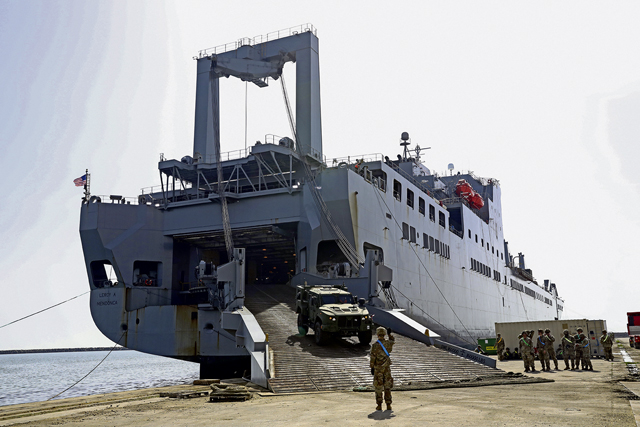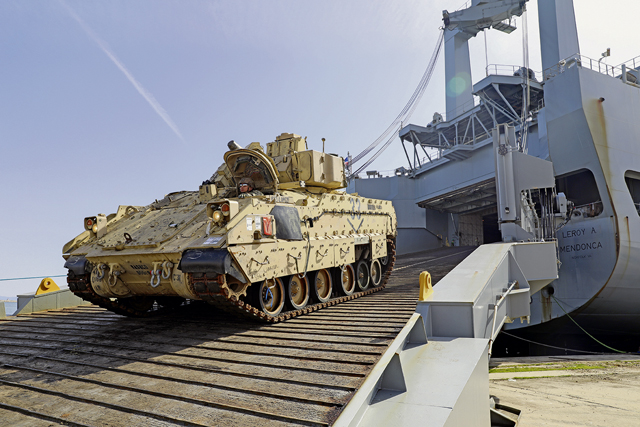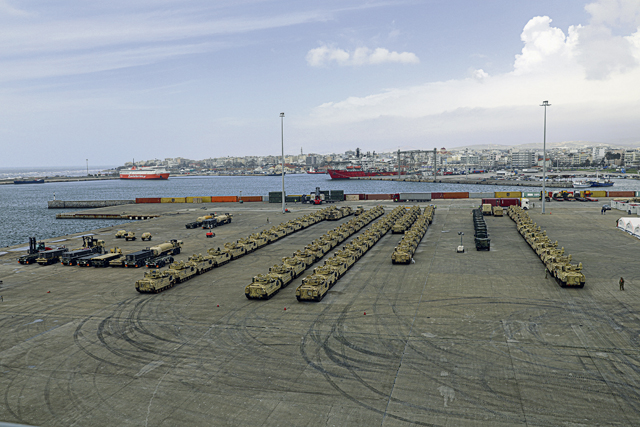
The Port of Alexandroupolis cemented another key moment for sustainment history as it facilitated the reception, staging, and onward movement of the first “heavy” brigade in Greece March 11. The 16th Sustainment Brigade and 598th Transportation Brigade, with the help of Hellenic and Greek Allies, moved approximately 3,000 pieces of equipment off the cargo vessel Leroy A. Mendoca for the 3rd Armored Brigade Combat Team, 4th Infantry Division’s rotational deployment in Europe.
Prior to 2012, an ABCT was called a heavy brigade combat team. The 3rd ABCT’s equipment includes tanks such as M1 Abrams, M2 Bradley Infantry Fighting Vehicles, and other support vehicles. The unit has seven battalions with more than 3,500 Soldiers that will be spread across Europe to enable the defense of NATO territory.
Maj. Steven Chase, deputy officer-in-charge of 3rd ABCT’s port operation, said the coalition of U.S. and Greek elements were essential to making this mission happen, due to the sheer size of the unit and its equipment.

“Here at the port, we are proving a concept,” said Chase. “For the first time, an entire armored brigade combat team is moving through this particular port. An armored brigade combat team is very resource-intensive to deploy. It occupies a significant amount of space, it’s very difficult to move from a logistical standpoint, and sustainment of this element is very difficult.”
This specific movement further demonstrated the strong relationship between U.S. and Hellenic Armed Forces and proved the Port of Alexandroupolis to be a premier gateway to Southern Europe. From a logistics standpoint, Greece has been a key geostrategic node to rapidly deploy personnel and equipment to the point of need.
Capt. Janine Donnelly-Cole, 624th Movement Control Team commander, which falls under the 16th Sustainment Brigade, said this mission is important to generate rapid combat power across the European theater. The port’s capabilities allowed U.S. and Greek personnel to conduct commercial line haul and staging for rail movement at the same time.

“As the vessel is downloaded by SDDC [598th], my team is doing simultaneous operations of loading up commercial line haul and rail going to the final destination,” said Donnelly-Cole. “For this mission there’s nine different locations we are sending the equipment to across Poland and Bulgaria.”
Capt. Ellen Gensicki, Delta Company commander, 588th Brigade Engineer Battalion, 3rd ABCT, said the collective sustainment efforts at the port strengthened NATO relationships.
“It is an honor to work with our NATO allies and be able to experience not only the Greek culture, but enable NATO as a whole,” said Gensicki.
“Especially with 3rd brigade, a very competent and lethal brigade that is ready to answer the call. Since we are pairing with NATO, it just helps to further our relations.”
The Port of Alexandroupolis’ previous key moments include receiving the largest vessel ever to birth, Arc Endurance, as well as the longest vessels to ever birth, the USNS Mendonca and USNS Brittin. Along with the United States, five other NATO allies have used this port for their logistic missions: France, Italy, United Kingdom, Spain, and Portugal.
This historic mission continued to prove Greece as a key NATO ally to assist in the execution of NATO regional plans. The collective sustainment effort between the United States and Greece at the Port of Alexandroupolis is great opportunity to showcase joint logistics across Europe in a contested environment.


